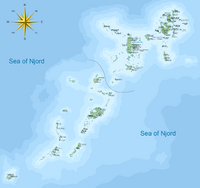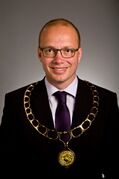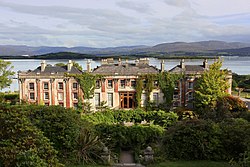Tårnøerne: Difference between revisions
No edit summary |
|||
| Line 6: | Line 6: | ||
| locator map = Tower Islands.png | | locator map = Tower Islands.png | ||
| map_custom = | | map_custom = | ||
| native name = <br>Tårnøerne<small> ({{wpl|Danish language|Tynic}})</small><br>Turneyjar<small> ({{wpl|Icelandic language| | | native name = <br>Tårnøerne<small> ({{wpl|Danish language|Tynic}})</small><br>Turneyjar<small> ({{wpl|Icelandic language|Laugarán}})</small><br>Tower Ilands<small> ({{wp|Linguistic Purism|Anglish}}</small>) | ||
| native name link = | | native name link = | ||
| other_names = | | other_names = | ||
| Line 29: | Line 29: | ||
| population as of = 2017 | | population as of = 2017 | ||
| density = 25/km² | | density = 25/km² | ||
| ethnic groups = {{wp|Icelandic people| | | ethnic groups = {{wp|Icelandic people|Laugaráns}}, {{wp|Angles|Ambrosians}} | ||
| additional info = | | additional info = | ||
}} | }} | ||
The '''Tårnøerne''' ({{wpl|Linguistic purism|Anglish}}: ''Tower Ilands'', {{wpl|Icelandic language| | The '''Tårnøerne''' ({{wpl|Linguistic purism|Anglish}}: ''Tower Ilands'', {{wpl|Icelandic language|Laugarán}}: '' | ||
''Turneyjar'') are a {{wpl|Subarctic|hypoborean}} {{wpl|archipelago}} in the [[Sea of the Njord]], lying to the southwest of [[Ambrose]] and to the north of [[Swastria]]. The largest three groups of islands are the Stykkishólmur, Lagaurás, and Trumba islands, although several hundred smaller ones also make up the island chain. The Tårnøerne, lying on the edge of the [[Nordania|Nordanian Shelf]], are a constituent subdivision [[Helheim]], a realm of the [[Sjealand|Archkingdom of Sjealand]]. | ''Turneyjar'') are a {{wpl|Subarctic|hypoborean}} {{wpl|archipelago}} in the [[Sea of the Njord]], lying to the southwest of [[Ambrose]] and to the north of [[Swastria]]. The largest three groups of islands are the Stykkishólmur, Lagaurás, and Trumba islands, although several hundred smaller ones also make up the island chain. The Tårnøerne, lying on the edge of the [[Nordania|Nordanian Shelf]], are a constituent subdivision [[Helheim]], a realm of the [[Sjealand|Archkingdom of Sjealand]]. | ||
Continuously inhabited since the 8th century, the Tårnøerne have been central to many of Nordania's most important events. Dating as far back to the [[War of the Ambrosian Succession]], the sovereignty of the islands has been heavily contested between Sjealand and Ambrose for over 300 years. A period of Ambrosian control and development following the [[Great War of the North]] was reversed by the [[Continental War]], and with the exception of a [[War of the Njord|brief occupation]] from 1970-71, the islands have since been under Sjealandic administration, though Ambrose still mantains a nominal territorial claim over the islands. | Continuously inhabited since the 8th century, the Tårnøerne have been central to many of Nordania's most important events. Dating as far back to the [[War of the Ambrosian Succession]], the sovereignty of the islands has been heavily contested between Sjealand and Ambrose for over 300 years. A period of Ambrosian control and development following the [[Great War of the North]] was reversed by the [[Continental War]], and with the exception of a [[War of the Njord|brief occupation]] from 1970-71, the islands have since been under Sjealandic administration, though Ambrose still mantains a nominal territorial claim over the islands. | ||
The population of the Tårnøerne is made up of mostly {{wpl|Icelandic people| | The population of the Tårnøerne is made up of mostly {{wpl|Icelandic people|Laugarán people}}, and as such, the ''{{wpl|lingua franca}}'' of the islands is {{wpl|Icelandic language|Laugarán}}, though {{wpl|Danish language|Tynic}} also enjoys official status. Despite this, there remains a sizeable minority of {{wpl|Linguistic purism|Anglish}}-speaking {{wpl|Anglo-Saxons|Brunswicker Ambrosian}} settlers, mainly concentrated the city of Ambrösihöfn (Anglish: ''Port Ambrose'') and across the northernmost islands. | ||
The Tårnøerne are dominated by their rugged terrain and their {{wpl|subpolar oceanic climate}}, with the rocky, infertile soil precluding large-scale agriculture. Instead, the islands have historically been home to a thriving {{wpl|fishing}} and {{wpl|whaling}} industry. In the past few decades, {{wpl|undersea oil drilling}} has also increased substantially. | The Tårnøerne are dominated by their rugged terrain and their {{wpl|subpolar oceanic climate}}, with the rocky, infertile soil precluding large-scale agriculture. Instead, the islands have historically been home to a thriving {{wpl|fishing}} and {{wpl|whaling}} industry. In the past few decades, {{wpl|undersea oil drilling}} has also increased substantially. | ||
| Line 53: | Line 53: | ||
[[File:Fiskeskibe på Færøerne (ES-164767).jpg|250px|thumb|right|Fishing boats on the Gjógy (Jogey) waterfront, 1886. The fishing industry would expand dramatically under Ambrosian rule]] | [[File:Fiskeskibe på Færøerne (ES-164767).jpg|250px|thumb|right|Fishing boats on the Gjógy (Jogey) waterfront, 1886. The fishing industry would expand dramatically under Ambrosian rule]] | ||
Amlodd justified the population expulsion by the need to use to the Tynic residents' homes for Ambrosian settlers. With his backing, the confederal government offered land grants to Ambrosians who moved to populate the islands. This tactic was successful, and by 1877 the population had undergone a drastic demographic change, with Ambrosian settlers (mainly ethnic {{wpl|Anglo-Saxons|Brunswickers}} making up 40.2% of the population. The islands underwent a process of {{wpl|Anglicization}}, with towns, regions, and street names renamed to {{wpl|Linguistic purism|Anglish}}. Nevertheless, after the 1880s, restrictions were relaxed on the use of the {{wpl|Icelandic language| | Amlodd justified the population expulsion by the need to use to the Tynic residents' homes for Ambrosian settlers. With his backing, the confederal government offered land grants to Ambrosians who moved to populate the islands. This tactic was successful, and by 1877 the population had undergone a drastic demographic change, with Ambrosian settlers (mainly ethnic {{wpl|Anglo-Saxons|Brunswickers}} making up 40.2% of the population. The islands underwent a process of {{wpl|Anglicization}}, with towns, regions, and street names renamed to {{wpl|Linguistic purism|Anglish}}. Nevertheless, after the 1880s, restrictions were relaxed on the use of the {{wpl|Icelandic language|Laugarán language}}, which was permitted as an official language and taught alongside Anglish in specially-designated areas where it was still spoken by a majority. | ||
The post-war economy of the Tower Islands was undermined by the fact that, even without the Sjealandic monopoly, Ambrose and its small merchant fleet could not hope to make any significant profit in overseas trade with the Orient; thus the role of the islands as a trade center further diminished, with Tuthinan trade shifting to Sjealandic [[Vestmannaland]]. However, one resource Elsbridge saw in the island were the vast {{wpl|fisheries}} in its waters, with Crovan writing in 1862: <blockquote>...focused on the East for the past century, the Tyns haven't even bothered to scratch the surface of their gold mine; a gold mine of cod, haddock, and whale.</blockquote> With the arrival of experienced Ambrosian fishermen from the [[Scarfskerry Cape]], fishing turned from a minor subsistence lifestyle into a massively-profitable industry. By 1890, analysts in Port Ambrose estimated in a report that the fisheries generated an amount of revenue exceeding the cost of local government. Packing houses and {{wpl|canneries}} became the dominant employers and the {{wpl|market towns}} of old became fishing harbors and whaling ports. | The post-war economy of the Tower Islands was undermined by the fact that, even without the Sjealandic monopoly, Ambrose and its small merchant fleet could not hope to make any significant profit in overseas trade with the Orient; thus the role of the islands as a trade center further diminished, with Tuthinan trade shifting to Sjealandic [[Vestmannaland]]. However, one resource Elsbridge saw in the island were the vast {{wpl|fisheries}} in its waters, with Crovan writing in 1862: <blockquote>...focused on the East for the past century, the Tyns haven't even bothered to scratch the surface of their gold mine; a gold mine of cod, haddock, and whale.</blockquote> With the arrival of experienced Ambrosian fishermen from the [[Scarfskerry Cape]], fishing turned from a minor subsistence lifestyle into a massively-profitable industry. By 1890, analysts in Port Ambrose estimated in a report that the fisheries generated an amount of revenue exceeding the cost of local government. Packing houses and {{wpl|canneries}} became the dominant employers and the {{wpl|market towns}} of old became fishing harbors and whaling ports. | ||
Revision as of 09:08, 21 April 2019
This article is incomplete because it is pending further input from participants, or it is a work-in-progress by one author. Please comment on this article's talk page to share your input, comments and questions. Note: To contribute to this article, you may need to seek help from the author(s) of this page. |
| Disputed island Native name: Tårnøerne (Tynic) Turneyjar (Laugarán) Tower Ilands (Anglish) | |
|---|---|
 View of the south from Neskaupstaður | |
| Geography | |
 | |
| Location | Sea of Njord (Nordania) |
| Total islands | 476 (39 inhabited) |
| Major islands | Vágar, Norðeyja, Sørøya |
| Area | 3855 km² |
| Highest point |
|
| Administered by | |
| Sjealand | |
| Realm | Helheim |
| Claimed by | |
| Ambrose | |
| County | Towers Ilands |
| Demographics | |
| Population | 96,673 (as of 2017) |
| Density | 25/km²/km² |
| Ethnic groups | Laugaráns, Ambrosians |
The Tårnøerne (Anglish: Tower Ilands, Laugarán: Turneyjar) are a hypoborean archipelago in the Sea of the Njord, lying to the southwest of Ambrose and to the north of Swastria. The largest three groups of islands are the Stykkishólmur, Lagaurás, and Trumba islands, although several hundred smaller ones also make up the island chain. The Tårnøerne, lying on the edge of the Nordanian Shelf, are a constituent subdivision Helheim, a realm of the Archkingdom of Sjealand.
Continuously inhabited since the 8th century, the Tårnøerne have been central to many of Nordania's most important events. Dating as far back to the War of the Ambrosian Succession, the sovereignty of the islands has been heavily contested between Sjealand and Ambrose for over 300 years. A period of Ambrosian control and development following the Great War of the North was reversed by the Continental War, and with the exception of a brief occupation from 1970-71, the islands have since been under Sjealandic administration, though Ambrose still mantains a nominal territorial claim over the islands.
The population of the Tårnøerne is made up of mostly Laugarán people, and as such, the lingua franca of the islands is Laugarán, though Tynic also enjoys official status. Despite this, there remains a sizeable minority of Anglish-speaking Brunswicker Ambrosian settlers, mainly concentrated the city of Ambrösihöfn (Anglish: Port Ambrose) and across the northernmost islands.
The Tårnøerne are dominated by their rugged terrain and their subpolar oceanic climate, with the rocky, infertile soil precluding large-scale agriculture. Instead, the islands have historically been home to a thriving fishing and whaling industry. In the past few decades, undersea oil drilling has also increased substantially.
History
Early settlement
Tuthinan trade center

Ambrosian rule
With the outbreak of the Great War of the North, Ambrosian President Godfred Crovan outlined the acquisition of the islands as one of his primary military goals. This had become possible with the Royal Sjealandic Navy's confinement port by late 1862, isolating the Royal Sjealandic Army's relatively few troops stationed on the islands. This allowed for a force under General George Amlodd to land on the central islands on February 3, 1863. With limited resources, Amlodd's forces avoided direct engagement with army strongholds and local militia, instead surrounding and besieging the capital of Stykkishólmur. Under the threat of naval bombardment, the city garrison surrendered the islands a week later, allowing the Ambrosians full control over the islands, who established martial law. The breakout of the Sjealandian fleet in late 1864 saw a renewed threat to the islands, however an 1865 landing attempting to recapture the southern islands was inconclusive and the Sjealandians withdrew.
The Congress of Dalganburgh formally saw sovereignty of the islands transferred to Ambrose. The Ambrosian military administration ended on February 10, 1868, and was replaced by the Thanedred of the Tower Islands, though it enjoyed less autonomy from Elsbridge than other thanedreds of the Confederal Republic, and Amlodd remained provisional governor until elections were held in 1875. While the Øic were allowed the choice between emigrating to Sjealand or accepting Ambrosian citizenship, the vast majority of the Tynic-speaking population was deported to Sjealand. In all, about 32% of the pre-war population (mostly ethnic Tynics) left the islands between 1867 and 1877.
Amlodd justified the population expulsion by the need to use to the Tynic residents' homes for Ambrosian settlers. With his backing, the confederal government offered land grants to Ambrosians who moved to populate the islands. This tactic was successful, and by 1877 the population had undergone a drastic demographic change, with Ambrosian settlers (mainly ethnic Brunswickers making up 40.2% of the population. The islands underwent a process of Anglicization, with towns, regions, and street names renamed to Anglish. Nevertheless, after the 1880s, restrictions were relaxed on the use of the Laugarán language, which was permitted as an official language and taught alongside Anglish in specially-designated areas where it was still spoken by a majority.
The post-war economy of the Tower Islands was undermined by the fact that, even without the Sjealandic monopoly, Ambrose and its small merchant fleet could not hope to make any significant profit in overseas trade with the Orient; thus the role of the islands as a trade center further diminished, with Tuthinan trade shifting to Sjealandic Vestmannaland. However, one resource Elsbridge saw in the island were the vast fisheries in its waters, with Crovan writing in 1862:
...focused on the East for the past century, the Tyns haven't even bothered to scratch the surface of their gold mine; a gold mine of cod, haddock, and whale.
With the arrival of experienced Ambrosian fishermen from the Scarfskerry Cape, fishing turned from a minor subsistence lifestyle into a massively-profitable industry. By 1890, analysts in Port Ambrose estimated in a report that the fisheries generated an amount of revenue exceeding the cost of local government. Packing houses and canneries became the dominant employers and the market towns of old became fishing harbors and whaling ports.

Worried of Sjealandic retribution, and noting the ease with which the islands fell in 1863, Ambrose established a significant military presence on the islands even after the end of martial law. The natural harbor at Stykkishólmur made it a prime location for a naval coaling station, with half of the Ambrosian Njord Squadron based out of it in 1915. The Confederal Army began an extensive program of seaboard defense, constructing fortifications on the island. Between 1867 and 1917, 14 different coastal forts were built, eschewing the pre-war system of masonry forts with the first modern concrete ones. In terms of armament, they were armed with large breech-loading cannons mounted on "disappearing carriages" as well as with the new 305 mm heavy mortars. This military buildup, decried as aggression by Asgård, reached its peak in the 1910s, when the Ambrosian garrison rivaled the entire population of the Trumba Islands.
Return to Sjealand
War of the Njord to present
Government

|

|
| Frederik VI Archking |
Søren Rommedahl Viceroy of Helheim |
The terms Tårnøerne and Tower Islands are both geographical descriptors, as the islands are not administrated as a singular entity. Instead, since the reoccupation by Sjealand in 1923, they have been divided into two municipal districts known as Fjórðungur (Camaines). Laugarás Fjórðungur consists of the southern islands, from Akrar (Acre) to Kolbeinsey, with the seat of government being the town of Laugarás. Utan Norðurs Fjórðungur (Outer North) consists of the northern islands, with the seat of government being in Ambrösihöfn (Port Ambrose). Proposals to amalgamate the two districts have been entertained in recent years, but are controversial due to their ethnic and cultural differences.
Each Fjórðungur is led by an Kosningarjarl (Walejarl, or "elected earl"), who presides over an elected council. These councils represent the different Deilds (Wards) of the island; both councils consist of independent councillors. The incumbent Kosningarjarls are Jens Símun Jónsson of Laugarás Fjórðungur and Osfred Godwinson of Utan Norðurs Fjórðungur.
Both Fjórðungur are part of the Viceroyalty of Helheim, and as such are under the authority of Viceroy Søren Rommedahl's government in Varhaugr; additionally, the Royal Sjealandic Defence has direct authority over the base areas of Laugarás AFB, Tjørnuvík AFB, and the Ambrösihöfn Naval Station. Aside from these, however, the two Fjórðungur enjoy substantial devolution from Varhaugr, such as the ability to jointly self-administer their own fishing waters and ferry links.
The islands are represented in the Rigsdag, making up 10 of Sjealand's 400 electoral circles; this number, which was increased from 4 in 1973, is significantly disproportionate to the population of the islands, making up 2.5% of national constituencies despite making up less than 1% of the country's population. This situation, which was instituted after the 1971 war as means to give the islands a larger voice, is controversial among mainlanders. All ten seats are occupied by the Tårnøernes Parti (Tower Islanders Party), a centrist regional interests group which holds 9 additional party list seats as of 2018.
Geography
Islands
North Islands
South Islands
Economy
Energy
Fishing and Whaling
Tourism
Military
The Royal Sjealandic Defence is the single largest employer on the islands. In the aftermath of the War of the Njord, the military presence became much more pronounced; the Tårnøerne is now home to installations of all three service branches (Army, Navy, Air Force) of His Majesty's Armed Forces. A mere five kilometers from the center of Port Ambrose is the Ambrösihofn Naval Station, the home port of the Royal Sjealandic Navy's 1st Strike Group Riget. The station is one of the largest on the Sea of Njord, second only to the Flådestation Frederiksværn; it has berths for multiple capital shipS, including the two Nordsøriget-class aircraft carriers attached to the strike group. In addition to this, private commercial contractors in Port Ambrose are sometimes contracted by the Navy for ship repair and maintenance.
The Royal Sjealandic Air Force maintains a squadron of Haastrup KF-25 Falken fighters (No. 113) at Laugarás Air Force Base. In addition to this, the Air Force rents runway and hangar space from the civilian Guðlakur Tórur Tórðursson International Airport at Tjørnuvík; here is based a squadron of Ræven FKH utility helicopters, as well as two Azimut Chronos maritime patrol aircraft.



